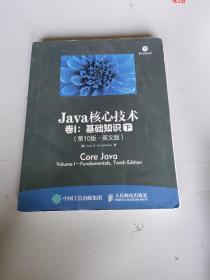
Java核心技术 卷I 基础知识 第10版 英文版 下册/
¥ 6 八五品
仅1件
山西太原
认证卖家担保交易快速发货售后保障
作者[美]凯·S.霍斯特曼(Cay,S.,Horstmann) 著
出版社人民邮电出版社
出版时间2016-06
版次1
装帧平装
货号222
上书时间2024-08-28
- 最新上架
商品详情
- 品相描述:八五品
图书标准信息
- 作者 [美]凯·S.霍斯特曼(Cay,S.,Horstmann) 著
- 出版社 人民邮电出版社
- 出版时间 2016-06
- 版次 1
- ISBN 9787115420114
- 定价 109.00元
- 装帧 平装
- 开本 16开
- 纸张 胶版纸
- 页数 955页
- 字数 1172千字
- 正文语种 英语
- 【内容简介】
-
本书是经典的《Java核心技术 卷I:基础知识》的新版。这一版针对Java SE 8平台进行了全面更新,以反映Java SE 8的特性。
书中囊括了Java的全部基础知识,提供了大量完整且具有实际意义的应用示例,详细介绍了Java语言基础、面向对象编程、反射与代理、接口与内部类、事件监听器模型、使用Swing GUI工具进行图形用户界面程序设计、打包应用程序、异常处理、登录与调试、泛型编程、集合框架、多线程、并发等内容。 - 【作者简介】
- Cay S. Horstmann 是Scala for the Impatient的作者,还与人合著了Core JavaServer Faces。他是圣何塞州立大学计算机科学专业的教授,还是一名Java Champion,并经常在很多开发者大会上演讲。
- 【目录】
-
目录
Chapter 1: An Introduction to Java / Java概述 1
1.1 Java as a Programming Platform / Java程序设计平台 1
1.2 The Java“White Paper”Buzzwords / Java“白皮书”中的口号 2
1.2.1 Simple / 简单 3
1.2.2 Object-Oriented / 面向对象 4
1.2.3 Distributed / 分布式 4
1.2.4 Robust / 健壮 4
1.2.5 Secure / 安全 4
1.2.6 Architecture-Neutral / 体系结构中立 5
1.2.7 Portable / 可移植 6
1.2.8 Interpreted / 解释型 7
1.2.9 High-Performance / 高性能 7
1.2.10 Multithreaded / 多线程 7
1.2.11 Dynamic / 动态 8
1.3 Java Applets and the Internet / Java Applet与Internet 8
1.4 A Short History of Java / Java简史 10
1.5 Common Misconceptions about Java / 对Java的常见误解 13
Chapter 2: The Java Programming Environment / Java编程环境 17
2.1 Installing the Java Development Kit / 安装Java开发包(JDK) 18
2.1.1 Downloading the JDK / 下载JDK 18
2.1.2 Setting up the JDK / 设置JDK 20
2.1.3 Installing Source Files and Documentation /源文件与文档的下载与设置 22
2.2 Using the Command-Line Tools / 使用命令行工具 23
2.3 Using an Integrated Development Environment / 使用集成开发环境 26
2.4 Running a Graphical Application / 运行图形化应用程序 30
2.5 Building and Running Applets / 构建并运行Applet 33
Chapter 3: Fundamental Programming Structures in Java / Java的基本编程结构 41
3.1 A Simple Java Program / 一个简单的Java程序 42
3.2 Comments / 注释 46
3.3 Data Types / 数据类型 47
3.3.1 Integer Types / 整型 47
3.3.2 Floating-Point Types / 浮点型 48
3.3.3 The char Type / char类型 50
3.3.4 Unicode and the char Type / Unicode与char类型 51
3.3.5 The boolean Type / boolean类型 52
3.4 Variables / 变量 53
3.4.1 Initializing Variables / 初始化变量 54
3.4.2 Constants / 常量 55
3.5 Operators / 运算符 56
3.5.1 Mathematical Functions and Constants / 数学函数与常量 57
3.5.2 Conversions between Numeric Types / 数值类型之间的转换 59
3.5.3 Casts / 强制类型转换 60
3.5.4 Combining Assignment with Operators / 组合赋值运算符 61
3.5.5 Increment and Decrement Operators / 自增运算符与自减运算符 61
3.5.6 Relational and Boolean Operators / 关系与boolean运算符 62
3.5.7 Bitwise Operators / 位运算符 63
3.5.8 Parentheses and Operator Hierarchy / 括号与运算符优先级 64
3.5.9 Enumerated Types / 枚举类型 65
3.6 Strings / 字符串 65
3.6.1 Substrings / 子串 66
3.6.2 Concatenation / 拼接 66
3.6.3 Strings Are Immutable / String是不可变的 67
3.6.4 Testing Strings for Equality / 测试字符串是否相等 68
3.6.5 Empty and Null Strings / 空串与null串 69
3.6.6 Code Points and Code Units / 码位与编码单元 70
3.6.7 The String API / String 类的API 71
3.6.8 Reading the Online API Documentation / 阅读在线API文档 74
3.6.9 Building Strings / 构建字符串 77
3.7 Input and Output / 输入输出 78
3.7.1 Reading Input / 读取输入 79
3.7.2 Formatting Output / 格式化输出 82
3.7.3 File Input and Output / 文件输入输出 87
3.8 Control Flow / 控制流 89
3.8.1 Block Scope / 块作用域 89
3.8.2 Conditional Statements / 条件语句 90
3.8.3 Loops / 循环 94
3.8.4 Determinate Loops / 确定性循环 99
3.8.5 Multiple Selections—The switch Statement / 多重选择:switch语句 103
3.8.6 Statements That Break Control Flow / 用于跳出控制流的语句 106
3.9 Big Numbers / 大数 108
3.10 Arrays / 数组 111
3.10.1 The “for each” Loop / “for each”循环 113
3.10.2 Array Initializers and Anonymous Arrays / 数组初始化与匿名数组 114
3.10.3 Array Copying / 数组复制 114
3.10.4 Command-Line Parameters / 命令行参数 116
3.10.5 Array Sorting / 数组排序 117
3.10.6 Multidimensional Arrays / 多维数组 120
3.10.7 Ragged Arrays / 不规则数组 124
Chapter 4: Objects and Classes /对象与类 129
4.1 Introduction to Object-Oriented Programming / 面向对象编程简介 130
4.1.1 Classes / 类 131
4.1.2 Objects / 对象 132
4.1.3 Identifying Classes / 识别类 133
4.1.4 Relationships between Classes / 类之间的关系 133
4.2 Using Predefined Classes / 使用预定义类 135
4.2.1 Objects and Object Variables / 对象与对象变量 136
4.2.2 The LocalDate Class of the Java Library / Java 库中的LocalDate类 139
4.2.3 Mutator and Accessor Methods / 更改器方法与访问器方法 141
4.3 Defining Your Own Classes / 定义自己的类 145
4.3.1 An Employee Class / Employee类 145
4.3.2 Use of Multiple Source Files / 使用多个源文件 149
4.3.3 Dissecting the Employee Class / 分析Employee类 149
4.3.4 First Steps with Constructors / 从构造器开始 150
4.3.5 Implicit and Explicit Parameters / 隐式参数与显式参数 152
4.3.6 Benefits of Encapsulation / 封装的好处 153
4.3.7 Class-Based Access Privileges / 基于类的访问权限 156
4.3.8 Private Methods / 私有方法 156
4.3.9 Final Instance Fields / final实例字段 157
4.4 Static Fields and Methods / 静态字段与静态方法 158
4.4.1 Static Fields / 静态字段 158
4.4.2 Static Constants / 静态常量 159
4.4.3 Static Methods / 静态方法 160
4.4.4 Factory Methods / 工厂方法 161
4.4.5 The main Method / main方法 161
4.5 Method Parameters / 方法参数 164
4.6 Object Construction / 对象构建 171
4.6.1 Overloading / 重载 172
4.6.2 Default Field Initialization / 默认字段初始化 172
4.6.3 The Constructor with No Arguments / 无参构造器 173
4.6.4 Explicit Field Initialization / 显式字段初始化 174
4.6.5 Parameter Names / 参数名 175
4.6.6 Calling Another Constructor / 调用另一个构造器 176
4.6.7 Initialization Blocks / 初始化块 177
4.6.8 Object Destruction and the finalize Method / 对象析构与finalize方法 181
4.7 Packages / 包 182
4.7.1 Class Importation / 导入类 183
4.7.2 Static Imports / 静态导入 185
4.7.3 Addition of a Class into a Package / 将类添加到某个包中 185
4.7.4 Package Scope / 包作用域 189
4.8 The Class Path / 类路径 190
4.8.1 Setting the Class Path / 设置类路径 193
4.9 Documentation Comments / 文档注释 194
4.9.1 Comment Insertion / 插入注释 194
4.9.2 Class Comments / 类注释 195
4.9.3 Method Comments / 方法注释 195
4.9.4 Field Comments / 字段注释 196
4.9.5 General Comments / 通用注释 196
4.9.6 Package and Overview Comments / 包与概述注释 198
4.9.7 Comment Extraction / 提取注释 198
4.10 Class Design Hints / 类设计建议 200
Chapter 5: Inheritance / 继承 203
5.1 Classes, Superclasses, and Subclasses / 类、超类与子类 204
5.1.1 Defining Subclasses / 定义子类 204
5.1.2 Overriding Methods / 覆盖方法 206
5.1.3 Subclass Constructors / 子类构造器 207
5.1.4 Inheritance Hierarchies / 继承层次 212
5.1.5 Polymorphism / 多态 213
5.1.6 Understanding Method Calls / 理解方法调用 214
5.1.7 Preventing Inheritance: Final Classes and Methods / 阻止继承:final修饰的类和方法 217
5.1.8 Casting / 强制类型转换 219
5.1.9 Abstract Classes / 抽象类 221
5.1.10 Protected Access / 受保护访问 227
5.2 Object: The Cosmic Superclass / Object:所有类的超类 228
5.2.1 The equals Method / equals方法 229
5.2.2 Equality Testing and Inheritance / 相等测试与继承 231
5.2.3 The hashCode Method / hashCode方法 235
5.2.4 The toString Method / toString方法 238
5.3 Generic Array Lists / 泛型数组列表 244
5.3.1 Accessing Array List Elements / 访问泛型数组列表的元素 247
5.3.2 Compatibility between Typed and Raw Array Lists / 泛型数组列表与原始数组列表的兼容性 251
5.4 Object Wrappers and Autoboxing / 对象包装器与自动装箱 252
5.5 Methods with a Variable Number of Parameters / 参数数量可变的方法 256
5.6 Enumeration Classes / 枚举类 258
5.7 Reflection / 反射 260
5.7.1 The Class Class / Class类 261
5.7.2 A Primer on Catching Exceptions / 捕获异常简介 263
5.7.3 Using Reflection to Analyze the Capabilities of Classes / 使用反射分析类的能力 265
5.7.4 Using Reflection to Analyze Objects at Runtime / 在运行时使用反射分析对象 271
5.7.5 Using Reflection to Write Generic Array Code / 使用反射编写泛型数组代码 276
5.7.6 Invoking Arbitrary Methods / 调用任意方法 279
5.8 Design Hints for Inheritance / 继承的设计建议 283
Chapter 6: Interfaces, Lambda Expressions, and Inner Classes / 接口、Lambda表达式和内部类 287
6.1 Interfaces / 接口 288
6.1.1 The Interface Concept / 接口的概念 288
6.1.2 Properties of Interfaces / 接口的特性 295
6.1.3 Interfaces and Abstract Classes / 接口与抽象类 297
6.1.4 Static Methods / 静态方法 298
6.1.5 Default Methods / 默认方法 298
6.1.6 Resolving Default Method Conflicts / 解决默认方法的冲突 300
6.2 Examples of Interfaces / 接口示例 302
6.2.1 Interfaces and Callbacks / 接口与回调 302
6.2.2 The Comparator Interface / Comparator接口 305
6.2.3 Object Cloning / 对象克隆 306
6.3 Lambda Expressions / Lambda表达式 314
6.3.1 Why Lambdas? / 为什么引入Lambda表达式 314
6.3.2 The Syntax of Lambda Expressions / Lambda表达式的语法 315
6.3.3 Functional Interfaces / 函数式接口 318
6.3.4 Method References / 方法引用 319
6.3.5 Constructor References / 构造器引用 321
6.3.6 Variable Scope / 变量作用域 322
6.3.7 Processing Lambda Expressions / 处理Lambda表达式 324
6.3.8 More about Comparators / 再谈Comparator 328
6.4 Inner Classes / 内部类 329
6.4.1 Use of an Inner Class to Access Object State / 使用内部类访问对象状态 331
6.4.2 Special Syntax Rules for Inner Classes /
内部类的特殊语法规则 334
6.4.3 Are Inner Classes Useful? Actually Necessary? Secure? / 内部类是否有用、必要和安全 335
6.4.4 Local Inner Classes / 局部内部类 339
6.4.5 Accessing Variables from Outer Methods / 从外部方法访问变量 339
6.4.6 Anonymous Inner Classes / 匿名内部类 342
6.4.7 Static Inner Classes / 静态内部类 346
6.5 Proxies / 代理 350
6.5.1 When to Use Proxies / 何时使用代理 350
6.5.2 Creating Proxy Objects / 创建代理对象 350
6.5.3 Properties of Proxy Classes / 代理类的特性 355
Chapter 7: Exceptions, Assertions, and Logging /异常、断言与日志 357
7.1 Dealing with Errors / 处理错误 358
7.1.1 The Classification of Exceptions / 异常分类 359
7.1.2 Declaring Checked Exceptions / 声明检查型异常 361
7.1.3 How to Throw an Exception / 如何抛出异常 364
7.1.4 Creating Exception Classes / 创建异常类 365
7.2 Catching Exceptions / 捕获异常 367
7.2.1 Catching an Exception / 捕获一个异常 367
7.2.2 Catching Multiple Exceptions / 捕获多个异常 369
7.2.3 Rethrowing and Chaining Exceptions / 再次抛出异常与异常链 370
7.2.4 The finally Clause / finally子句 372
7.2.5 The Try-with-Resources Statement / try-with-resources语句 376
7.2.6 Analyzing Stack Trace Elements / 分析栈轨迹元素 377
7.3 Tips for Using Exceptions / 异常使用技巧 381
7.4 Using Assertions / 使用断言 384
7.4.1 The Assertion Concept / 断言的概念 384
7.4.2 Assertion Enabling and Disabling / 启用和禁用断言 385
7.4.3 Using Assertions for Parameter Checking / 使用断言检查参数 386
7.4.4 Using Assertions for Documenting Assumptions / 使用断言保证文档中假定成立的条件 387
7.5 Logging / 日志 389
7.5.1 Basic Logging / 基本日志 389
7.5.2 Advanced Logging / 高级日志 390
7.5.3 Changing the Log Manager Configuration / 修改日志管理器配置 392
7.5.4 Localization / 本地化 393
7.5.5 Handlers / 处理器 394
7.5.6 Filters / 过滤器 398
7.5.7 Formatters / 格式化器 399
7.5.8 A Logging Recipe / 常见日志操作总结 399
7.6 Debugging Tips / 调试技巧 409
Chapter 8: Generic Programming /泛型编程 415
8.1 Why Generic Programming? / 为什么要使用泛型编程 416
8.1.1 The Advantage of Type Parameters / 类型参数的好处 416
8.1.2 Who Wants to Be a Generic Programmer? / 哪些人想成为泛型程序员 417
8.2 Defining a Simple Generic Class / 定义简单的泛型类 418
8.3 Generic Methods / 泛型方法 421
8.4 Bounds for Type Variables / 类型变量的绑定 422
8.5 Generic Code and the Virtual Machine / 泛型代码与虚拟机 425
8.5.1 Type Erasure / 类型擦除 425
8.5.2 Translating Generic Expressions / 翻译泛型表达式 426
8.5.3 Translating Generic Methods / 翻译泛型方法 427
8.5.4 Calling Legacy Code / 调用遗留代码 429
8.6 Restrictions and Limitations / 约束与局限性 430
8.6.1 Type Parameters Cannot Be Instantiated with Primitive Types / 类型参数不能用基本类型来实例化 430
8.6.2 Runtime Type Inquiry Only Works with Raw Types / 运行时类型查询只适用于原始类型 431
8.6.3 You Cannot Create Arrays of Parameterized Types / 不能创建参数化类型的数组 431
8.6.4 Varargs Warnings / 注意变长参数情况 432
8.6.5 You Cannot Instantiate Type Variables / 不能实例化类型变量 433
8.6.6 You Cannot Construct a Generic Array / 不能构造泛型数组 434
8.6.7 Type Variables Are Not Valid in Static Contexts of Generic Classes / 类型变量在泛型类的静态上下文中无效 436
8.6.8 You Cannot Throw or Catch Instances of a Generic Class / 不能抛出或捕获泛型类的实例 436
8.6.9 You Can Defeat Checked Exception Checking / 可以打破“检查型异常必须检查”的规则 437
8.6.10 Beware of Clashes after Erasure / 注意类型擦除后的冲突 439
8.7 Inheritance Rules for Generic Types / 泛型类型的继承规则 440
8.8 Wildcard Types / 通配符类型 442
8.8.1 The Wildcard Concept / 通配符的概念 442
8.8.2 Supertype Bounds for Wildcards / 通配符的超类型限定 444
8.8.3 Unbounded Wildcards / 无限定通配符 447
8.8.4 Wildcard Capture / 通配符捕获 448
8.9 Reflection and Generics / 反射与泛型 450
8.9.1 The Generic Class Class / 泛型的Class类 450
8.9.2 Using ClassParameters for Type Matching / 使用Class 参数进行类型匹配 452
8.9.3 Generic Type Information in the Virtual Machine / 虚拟机中的泛型类型信息 452
Chapter 9: Collections /集合类 459
9.1 The Java Collections Framework / Java 集合类框架 460
9.1.1 Separating Collection Interfaces and Implementation / 将集合类的接口与实现分离 460
9.1.2 The Collection Interface / Collection接口 463
9.1.3 Iterators / 迭代器 463
9.1.4 Generic Utility Methods / 泛型的实用方法 466
9.1.5 Interfaces in the Collections Framework / 集合类框架中的接口 469
9.2 Concrete Collections / 具体的集合类 472
9.2.1 Linked Lists / 链表 474
9.2.2 Array Lists / 数组列表 484
9.2.3 Hash Sets / 散列集 485
9.2.4 Tree Sets / 树形集 489
9.2.5 Queues and Deques / 队列与双端队列 494
9.2.6 Priority Queues / 优先级队列 495
9.3 Maps / 映射 497
9.3.1 Basic Map Operations / 基本映射操作 497
9.3.2 Updating Map Entries / 更新映射表项 500
9.3.3 Map Views / 映射视图 502
9.3.4 Weak Hash Maps / 弱散列映射 504
9.3.5 Linked Hash Sets and Maps / LinkedHashSet与LinkedHashMap 504
9.3.6 Enumeration Sets and Maps / EnumSet与EnumMap 506
9.3.7 Identity Hash Maps / IdentityHashMap 507
9.4 Views and Wrappers / 视图与包装器 509
9.4.1 Lightweight Collection Wrappers / 轻量级集合包装器 509
9.4.2 Subranges / 子范围 510
9.4.3 Unmodifiable Views / 不可修改视图 511
9.4.4 Synchronized Views / 同步视图 512
9.4.5 Checked Views / 检查用视图 513
9.4.6 A Note on Optional Operations / 可选操作说明 514
9.5 Algorithms / 算法 517
9.5.1 Sorting and Shuffiing / 排序与混排 518
9.5.2 Binary Search / 二分查找 521
9.5.3 Simple Algorithms / 简单算法 522
9.5.4 Bulk Operations / 主要操作 524
9.5.5 Converting between Collections and Arrays / 集合与数组之间的转换 525
9.5.6 Writing Your Own Algorithms / 编写自己的算法 526
9.6 Legacy Collections / 遗留的集合类 528
9.6.1 The Hashtable Class / Hashtable类 528
9.6.2 Enumerations / Enumeration 528
9.6.3 Property Maps / 属性映射 530
9.6.4 Stacks / 栈 531
9.6.5 Bit Sets / 位集 532
Chapter 10: Graphics Programming /图形界面编程 537
10.1 Introducing Swing / Swing简介 538
10.2 Creating a Frame / 创建框架 543
10.3 Positioning a Frame / 设定框架的显示位置 546
10.3.1 Frame Properties / 框架属性 549
10.3.2 Determining a Good Frame Size / 确定合适的框架大小 549
10.4 Displaying Information in a Component / 在组件中显示信息 554
10.5 Working with 2D Shapes / 处理2D图形 560
10.6 Using Color / 使用颜色 569
10.7 Using Special Fonts for Text / 使用特殊的文本字体 573
10.8 Displaying Images / 显示图片 582
Chapter 11: Event Handling /事件处理 587
11.1 Basics of Event Handling / 事件处理基础 587
11.1.1 Example: Handling a Button Click / 示例:处理按钮点击事件 591
11.1.2 Specifying Listeners Concisely / 设置监听器的简洁方法 595
11.1.3 Example: Changing the Look-and-Feel / 示例:修改观感 598
11.1.4 Adapter Classes / 适配器类 603
11.2 Actions / 动作 607
11.3 Mouse Events / 鼠标事件 616
11.4 The AWT Event Hierarchy / AWT事件层次 624
11.4.1 Semantic and Low-Level Events / 语义与底层事件 626
Chapter 12: User Interface Components with Swing / Swing用户界面组件 629
12.1 Swing and the Model-View-Controller Design Pattern / Swing与模型-视图-控制器设计模式 630
12.1.1 Design Patterns / 设计模式 630
12.1.2 The Model-View-Controller Pattern / 模型-视图-控制器模式 632
12.1.3 A Model-View-Controller Analysis of Swing Buttons / Swing按钮的模型-视图-控制器分析 636
12.2 Introduction to Layout Management / 布局管理简介 638
12.2.1 Border Layout / 边框布局 641
12.2.2 Grid Layout / 网格布局 644
12.3 Text Input / 文本输入 648
12.3.1 Text Fields / 文本框 649
12.3.2 Labels and Labeling Components / 标签与标签组件 651
12.3.3 Password Fields / 密码框 652
12.3.4 Text Areas / 文本区域 653
12.3.5 Scroll Panes / 滚动窗格 654
12.4 Choice Components / 选择组件 657
12.4.1 Checkboxes / 复选框 657
12.4.2 Radio Buttons / 单选按钮 660
12.4.3 Borders / 边框 664
12.4.4 Combo Boxes / 组合框 668
12.4.5 Sliders / 滑动条 672
12.5 Menus / 菜单 678
12.5.1 Menu Building / 菜单构建 679
12.5.2 Icons in Menu Items / 菜单项中的图标 682
12.5.3 Checkbox and Radio Button Menu Items / 复选框和单选按钮菜单项 683
12.5.4 Pop-Up Menus / 弹出菜单 684
12.5.5 Keyboard Mnemonics and Accelerators / 键盘助记符与快捷键 686
12.5.6 Enabling and Disabling Menu Items / 启用和禁用菜单项 689
12.5.7 Toolbars / 工具栏 694
12.5.8 Tooltips / 工具提示 696
12.6 Sophisticated Layout Management / 复杂的布局管理 699
12.6.1 The Grid Bag Layout / 网格布局管理 701
12.6.2 Group Layout / 组布局 713
12.6.3 Using No Layout Manager / 不使用布局管理器 723
12.6.4 Custom Layout Managers / 定制布局管理器 724
12.6.5 Traversal Order / 遍历顺序 729
12.7 Dialog Boxes / 对话框 730
12.7.1 Option Dialogs / 选项对话框 731
12.7.2 Creating Dialogs / 创建对话框 741
12.7.3 Data Exchange / 数据交换 746
12.7.4 File Dialogs / 文件对话框 752
12.7.5 Color Choosers / 颜色选择器 764
12.8 Troubleshooting GUI Programs / GUI程序的问题定位 770
12.8.1 Debugging Tips / 调试技巧 770
12.8.2 Letting the AWT Robot Do the Work / 把工作交给AWT Robot 774
Chapter 13: Deploying Java Applications / 部署Java应用程序 779
13.1 JAR Files / JAR文件 780
13.1.1 Creating JARfiles / 创建JAR文件 780
13.1.2 The Manifest / 清单文件 781
13.1.3 Executable JAR Files / 可执行的JAR文件 782
13.1.4 Resources / 资源 783
13.1.5 Sealing / 封闭 787
13.2 Storage of Application Preferences / 应用偏好信息的存储 788
13.2.1 Property Maps / 属性映射 788
13.2.2 The Preferences API / Properties API 794
13.3 Service Loaders / 服务加载器 800
13.4 Applets / Applet 802
13.4.1 A Simple Applet / 一个简单的Applet 803
13.4.2 The applet HTML Tag and Its Attributes / applet HTML标记及其属性 808
13.4.3 Use of Parameters to Pass Information to Applets / 使用参数向Applet传递信息 810
13.4.4 Accessing Image and Audio Files / 访问图片和音频文件 816
13.4.5 The Applet Context / Applet上下文 818
13.4.6 Inter-Applet Communication / Applet间的通信 818
13.4.7 Displaying Items in the Browser / 在浏览器中显示信息 819
13.4.8 The Sandbox / 沙箱 820
13.4.9 Signed Code / 签名代码 822
13.5 Java Web Start / Java Web Start 824
13.5.1 Delivering a Java Web Start Application / 交付一个Java Web Start应用 824
13.5.2 The JNLP API / JNLP API 829
Chapter 14: Concurrency /并发 839
14.1 What Are Threads? / 什么是线程 840
14.1.1 Using Threads to Give Other Tasks a Chance / 使用线程为其他任务提供执行机会 846
14.2 Interrupting Threads / 中断线程 851
14.3 Thread States / 线程状态 855
14.3.1 New Threads / 新创建线程 855
14.3.2 Runnable Threads / 可运行线程 855
14.3.3 Blocked and Waiting Threads / 被阻塞线程与等待线程 856
14.3.4 Terminated Threads / 被终止的线程 857
14.4 Thread Properties / 线程属性 858
14.4.1 Thread Priorities / 线程优先级 858
14.4.2 Daemon Threads / 守护线程 859
14.4.3 Handlers for Uncaught Exceptions / 未捕获异常的处理器 860
14.5 Synchronization / 同步 862
14.5.1 An Example of a Race Condition / 竞争条件的一个案例 862
14.5.2 The Race Condition Explained / 竞争条件详解 866
14.5.3 Lock Objects / 锁对象 868
14.5.4 Condition Objects / 条件对象 872
14.5.5 The synchronized Keyword / synchronized关键字 878
14.5.6 Synchronized Blocks / 同步块 882
14.5.7 The Monitor Concept / 监视器概念 884
14.5.8 Volatile Fields / volatile字段 885
14.5.9 Final Variables / final变量 886
14.5.10 Atomics / 原子 886
14.5.11 Deadlocks / 死锁 889
14.5.12 Thread-Local Variables / 线程局部变量 892
14.5.13 Lock Testing and Timeouts / 锁测试与超时 893
14.5.14 Read / Write Locks / 读/写锁 895
14.5.15 Why the stop and suspend Methods Are Deprecated / 为什么弃用stop和suspend方法 896
14.6 Blocking Queues / 阻塞队列 898
14.7 Thread-Safe Collections / 线程安全的集合 905
14.7.1 Efficient Maps, Sets, and Queues / 高效的映射、集和队列 905
14.7.2 Atomic Update of Map Entries / 映射表项的原子更新 907
14.7.3 Bulk Operations on Concurrent Hash Maps / 并发散列映射上的主要操作 909
14.7.4 Concurrent Set Views / 并发的集视图 912
14.7.5 Copy on Write Arrays / 写时复制的数组 912
14.7.6 Parallel Array Algorithms / 并行数组算法 912
14.7.7 Older Thread-Safe Collections / 较早的线程安全的集合 914
14.8 Callables and Futures / Callable与Future 915
14.9 Executors / 执行器 920
14.9.1 Thread Pools / 线程池 921
14.9.2 Scheduled Execution / 预订执行 926
14.9.3 Controlling Groups of Tasks / 控制任务组 927
14.9.4 The Fork-Join Framework / Fork-Join框架 928
14.9.5 Completable Futures / CompletableFuture 931
14.10 Synchronizers / 同步器 934
14.10.1 Semaphores / 信号量 935
14.10.2 Countdown Latches / 倒计时门栓 936
14.10.3 Barriers / 障栅 936
14.10.4 Exchangers / 交换器 937
14.10.5 Synchronous Queues / 同步队列 937
14.11 Threads and Swing / 线程与Swing 937
14.11.1 Running Time-Consuming Tasks / 运行耗时任务 939
14.11.2 Using the Swing Worker / 使用Swing工作线程 943
14.11.3 The Single-Thread Rule / 单线程规则 951
Appendix / 附录 953
点击展开
点击收起
— 没有更多了 —















以下为对购买帮助不大的评价